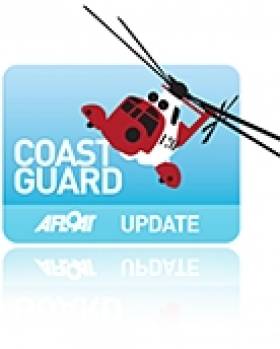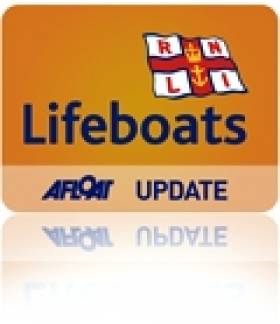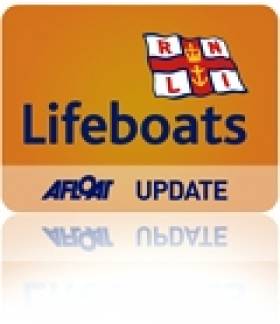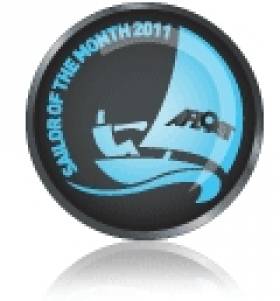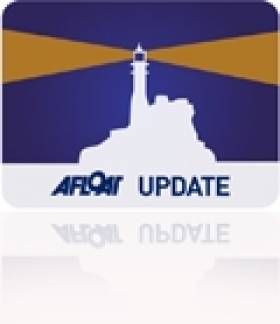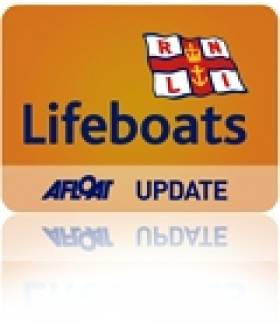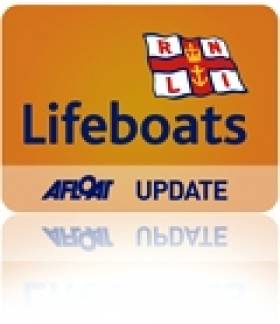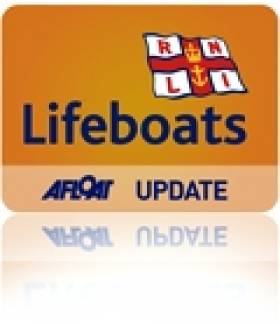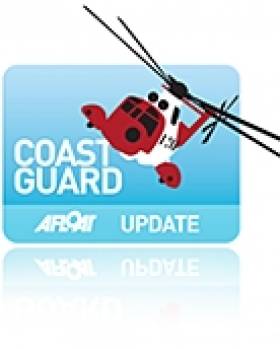Displaying items by tag: Rescue
Award for Helicopter Crews 'Outstanding Service' to Irish Maritime Search and Rescue
One of the world's leading helicopter services company, CHC has built up an unparalleled reputation for excellence in SAR aviation over 20 years of operations for the Irish Coast Guard.
The tireless efforts of the team, who provide a 24-hour a day service from their Shannon base, has seen them awarded a special Directors Award for Outstanding Service to maritime search and rescue in Ireland.
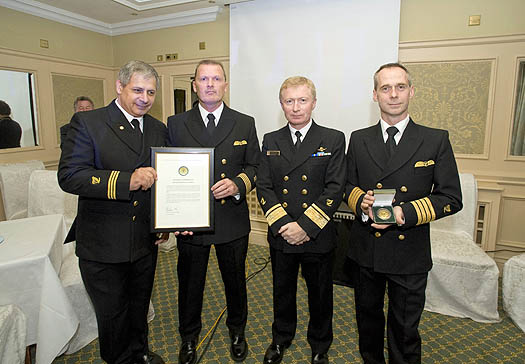
Top Brass: (from left to right) Paul Truss, Eamonn O'Broin, Chris Reynolds and Liam Flynn
The award recognises the personal commitment of all the crews, engineers and staff that have, over a period of two decades from 1991 to 2011, significantly enhanced Ireland's ability to affect a successful rescue and saved many lives.
It was accepted by Shannon Chief Pilot Captain Liam Flynn, Chief Crewman Eamonn O'Broin and Base Manager Paul Truss. Director of the Irish Coast Guard, Chris Reynolds, presented the award at a screening of a television documentary about the unit in Ennis.
The programme, called Rescue 115, will be aired on Irish channel RTE and will give people the opportunity to get an intimate view of what the crew does.
Mark Kelly, managing director of CHC in Ireland, said: "I would like to extend my heart felt congratulations to each and every member of the Shannon team past and present on the Directors Award in recognition of outstanding service to the State.
"The Directors Award is a very prestigious award which has only been given eight previous times.
"In presenting the award at the premiere of Rescue 115, Chris Reynolds spoke of the outstanding service given by the Shannon base and its staff to the State over the last twenty years, during which time it has carried out 3,732 missions.
"It is a well deserved recognition of two decades of tremendous courage, loyalty and dedication to providing a world class search and rescue service."
Earlier this year, a CHC SAR crew was recognised with a Best of Irish award for their role in successfully recovering the pilot of a light aircraft which crashed in the Irish Sea.
CHC Helicopter is the world's largest offshore helicopter operator and provides civilian search and rescue services in Ireland, the UK, Norway and Australia.
Lough Derg Lifeboat Rescues Three after Yacht Capsizes
At 17.04hrs Saturday September 10, Lough Derg RNLI Lifeboat was requested to launch by Valentia Coast Guard following a report of two persons in the water off Hare Island, on Lough Derg. At 17.15hrs, the lifeboat was launched with Helm Colin knight, Johnny Hoare and Ger Egan on board, and was on scene 17.20hrs. The wind was southwest, force 6, with a 5ft to 6ft swell, visibility was good.
When the RNL lifeboat arrived on scene, a passing yacht was recovering two persons onto their yacht, but had lost a visual on the third person. The lifeboat immediately carried out a search pattern, located the third casualty some four or five hundred metres away, and recovered them to the lifeboat.
Lifeboat Helm Colin Knight said "these three people were very very lucky; the passing yacht only became aware of their plight when, on tacking, one of sailors heard calls for help on the wind and raised the alarm". He continued, "the persons were in the water for at least thirty minutes, in fairly hostile conditions, when the only boat in the vicinity heard their calls for help, someone was looking after them today".
Tasked by Valentia Coast Guard, the Irish Coast Guard Search & Rescue Helicopter team, Rescue 115, took off from their base at Shannon at 17.34hrs. Killaloe Coast Guard had also launched to assist. After establishing that the RNLI lifeboat could be at their station within 5 minutes, Rescue 115 requested the crew to take the casualties to Dromineer from where they5 would transfer the casualties to hospital.
The RNLI lifeboat returned to the yacht, and took a second casualty on board. Killaloe Coast Guard boat took the third person. All were then rushed back to Drominneer where they were met by the helicopter and transferred to Limerick Regional hospital for further treatment.
The lifeboat then returned to 'The Hare' to see if the sunken vessel was a navigational hazard, but there was no sign of wreckage or of the yacht. The lifeboat returned to station and was ready for service again at 18.50hrs.
Two Rescued from Cruiser on Lough Derg
At 12.24hrs September 7 Lough Derg RNLI Lifeboat launched, following a request by Valentia Coast Guard to assist a vessel aground close to Terryglass Harbour at the Northern end of Lough Derg. The lifeboat, with helm Johnny Hoare, Ger Egan and David Moore on board, was alongside the casualty vessel at 12.51hrs. Winds were West Southwest, Force 4 gusting 5, with frequent squally showers reducing visibility.
The vessel was aground very close to the shore and the two persons on board were safe and unharmed. Two other passengers had walked to shore and made their way by road to Terryglass Harbour. The vessel had got into difficulties after it had gone to the assistance of another cruiser; this other vessel had made it's way to safe water and was tied alongside at Terryglass Harbour when the lifeboat arrived on scene. The vessel was taken off the rocks at 13.25hrs, she had suffered a lot of damage to her props but was not holed. With an RNLI crew member on board the vessel was towed to Terryglass and was tied alongside at 13.50hrs.
The lifeboat returned to station was ready for service again at 14.35hrs. Helm Johnny Hoare said that he was "pleased with the progress of the rescue considering the conditions on the lake and the position of the boat in very rocky water".
Kieran Cotter and Jerry Smith Named Sailors of the Month for August
When Rambler's canting keel snapped off on the evening of Monday August 15th shortly after this mega-machine had rounded the Rock, she was powering at full speed towards the turning buoy, crashing into the lumpy seas which often arise where the steep land juts into the open ocean.

Kieran Cotter and the crew of the Baltimore lifeboat at the capize site. Photo: Thierry Martinez
The catastrophe was total and very sudden. The giant racer completely inverted every bit as quickly as the smallest of racing dinghies. The changeover, from being a highly tuned performer on track for success, into the inverted hell of exploding water, strangling ropes and jagged breaking gear, was at the least totally disorienting, and could have caused panic in less seasoned sailors.
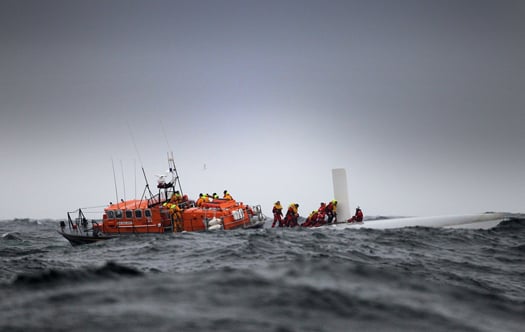
The Lifeboat rescue from the upturned hull. Photo: Team Phaedo
Despite the difficulty of clambering onto the ultra-smooth underside of the huge hull, fifteen of the crew managed to get themselves up to the minimal handhold of the dagger board. But five of those who had been below – some of them off watch asleep – had drifted away from the boat after the monumental struggle of escaping from a small world turned upside down.
The five in the water roped themselves together, but things had taken an ominous turn, as the mist in which the big boat had rounded the Fastnet had now thickened into fog. For a crucial period, visibility was virtually nonexistent as other boat raced past nearby at high speed. And although some emergency radio beacons had automatically activated, the picture was confused with night drawing on.

Drifting crew are rescued. Photo: Team Phaedo
Time was of the essence – even in summer these waters can quickly induce hypothermia. Several agencies were now involved in the rescue, and skilled use of technology narrowed the search area, though in the sea conditions the stricken boat and crew were frequently invisible.
It was the Baltimore lifeboat with Kieran Cotter in command which was first on the scene. Taking off the crew was a challenge, but all fifteen on the upturned Rambler were safely rescued, though an impact between lifeboat and white hull resulted in a streak of lifeboat blue on the yacht which was to be immortalised as "Kieran's kiss".
But that was later, not until after a needle-in-a-haystack search found the other five adrift together in the water, with one already on the edge of coma. They were found by the lifeboat deputy mechanic Jerry Smith, on patrol with a Fastnet Race film crew in his dive boat Wave Chieftain. It was a miracle.
Next morning safely in Baltimore, the weather was already well improved. The previous night's conditions seemed like a nightmare. In calm summery conditions two days later, the Rambler hull was righted off Barley Cove and towed to Baltimore. She'll be restored to full racing trim by Cookson's in New Zealand, presumably with modifications to the design and specification for the canting keel. But that's another day's work. Today, we celebrate the achievement of Kieran Cotter and Jerry Smith, whose seamanship provided the successful focus for a network of rapid work by skilled technologists ashore.
Coverage of the rescue appears in Afloat's Rolex Fastnet Race page
Roll Over Rambler... How to Right a SuperMaxi
Here's video of the salvage and righting operation after the capsize of the super maxi ocean racing yacht Rambler 100 during the Fastnet race 2011.
The 100-foot yacht capsized shorthly after rounding the Fastnet rock, the result it appears of a catastrophic keel failure.
All 21 crew were saved thanks to the work of the Irish emergency services. The footage is taken by Baltimore Sea Safari. All our Fastnet and Rambler 100 coverage is here.
RNLI Donaghadee and Bangor Lifeboats Launch to Rescue Five People
Belfast Coastguard received the initial 999 telephone call for help from crew onboard a third leisure fishing vessel which was in the area. Reports indicate that a 33ft leisure fishing boat and a 35ft leisure fishing boat had both experienced engine failure and were adrift close to Belfast shipping routes.
Within minutes of the rescue pagers being activated, volunteer crews had launched Donaghadee and Bangor Lifeboats and were proceeding at full speed towards the disabled vessels.
The two stricken boats were located 1 mile south of the Salt Jetty.
Relative calm on scene weather conditions allowed crew from RNLI Bangor Lifeboat to rig a tow line with the smaller of the two boats; she was then taken under tow to the safety of Carrickfergus Harbour.
Thankfully crew onboard the larger vessel were able to make engine repairs while RNLI Donaghadee Lifeboat stood close by. The vessel was then escorted to the safety of Carrickfergus Harbour.
RNLI volunteer station officer Kevin Baird used these rescues to highlight a RNLI safety message when he said. We always urge everyone going afloat to make sure their engine and fuel systems and are well maintained and in good working order. Engine failure close to shore and commercial shipping routes could lead to a life threatening situation'. He added 'We're happy that everyone onboard both vessels are now safely ashore'.
Wicklow Lifeboat Tows Yacht to Safety After Rope Fouls Prop
The yacht with two persons onboard was taking part in a race along the Wicklow coast when the mast and rigging was damaged, the skipper attempted to use the engine but a rope had fouled the propeller leaving the vessel drifting helplessly.
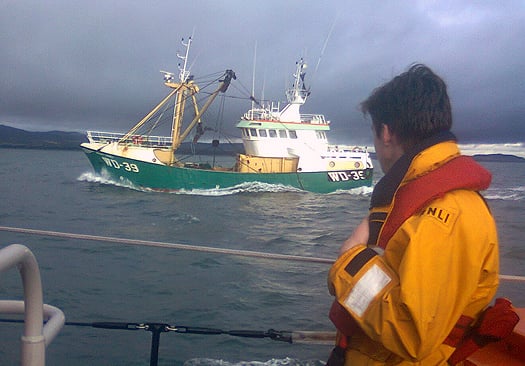
Wicklow lifeboat tows the yacht to safety last night
The lifeboat crew under the command of Coxswain Ciaran Doyle located the stricken yacht about one mile east of the North Arklow buoy and was alongside less than 30 minutes after launching. Once a towline had been rigged by the lifeboat crew the casualty was taken under tow to Wicklow harbour. The yacht was secured alongside the south quay at 7pm and the two sailors were landed safely ashore. This was the second incident the volunteer crew responded to over the weekend.
Lough Derg Lifeboat Investigates Reports of Unmanned Cruiser
At 17.05hrs Lough Derg RNLI Lifeboat launched with helm Eleanor Hooker, Peter Clarke and Ben Ronayne on board. As the lifeboat made its way to the casualty vessel, it was established that the skipper of the vessel, safe and unharmed, had been taken by a passing motor boat to Garrykennedy Harbour. It was noted that some boats, having seen the cruiser, were navigating the wrong side of the Mountaineer. The lifeboat took the skipper back to his vessel. The craft was not holed but had suffered damage to its props. With the boat's skipper and a lifeboat crew member on board, the vessel was taken off the rocks and towed to Williamstown Harbour, where it was tied up safely alongside at 18.40hrs. The lifeboat returned to station and were ready for service again at 19.00hrs.
Earlier today, at 10am Lough Derg RNLI lifeboat, Toshiba Wave Warrior, went to the assistance of 4 persons on board a 40ft cruiser that had run aground close to the mouth of the river in Terryglass Bay. The crew had hoisted their distress flag to draw attention to their dilemma.
At 10.45hrs on Sunday August 22, the crew of Lough Derg RNLI Lifeboat, helm Peter Clarke, Dom Sharkey and Ben Ronayne came across a vessel aground and flying her distess flag whilst out on exercise at the northern end of Lough Derg. They alerted Valentia Coast Guard that they were going to assist. Winds were westerly force 3 and visibility was very good. The vessel, which had been aground for two hours, had four crew, two of whom were in the water inspecting the hull. They were advised to get back onboard and to change into warm dry clothes. Having establishing that the boat was not holed, the lifeboat took her off the rocks and towed her to the safety of Portumna Castle Harbour, where she was tied up alongside at 11.20hrs. The lifeboat returned to station and was ready for service again at 12.57hrs
While it might be an exaggeration to say that all of the 21 crew members of Rambler 100 owe their lives to the Irish Search and Rescue service, there are certainly five people whose future prospects were greatly improved by the operation off the Fastnet Rock on August 15th. A lot of media focus has been on Coxswain Kieran Cotter and the crew of Baltimore Lifeboat as well as lifeboat mechanic Jerry Smith, whose dive boat, on charter to the media team of one of the competitors, was on hand to search and recover the five drifting crew. There is no question that this focus is appropriate. RNLI crews all over the UK and Ireland deserve the attention, not only because of their extraordinary voluntary dedication to the cause, but also because such publicity helps swell the coffers of the charity. The service could not operate without the generosity of the donors and incidents such as these help fill the blue boat-shaped boxes held by even more RNLI volunteers.
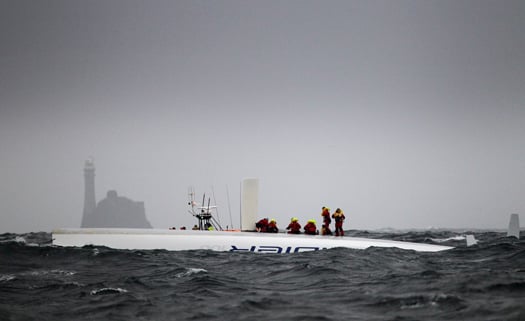
Saved: Ireland's Rescue Services Answered the Call of the capsized Supermaxi Rambler 100 off the Fastnet Rock. Photo: Team Phaedo
The dramatic stories and pictures dominating the media show the front line of a quite wonderful resource that is Search and Rescue in Ireland today. Baltimore Lifeboat was at the coal face of an intricate network of operations, triggered by the crew's EPIRBs. Irish Coast Guard radio officers in Valentia responded almost immediately tasking the rescue resources, working the phones and computers to confirm that this was not an accidentally triggered EPIRB, contacting RORC HQ, determining search patterns and relaying the information to the scene. It was the backroom contacts between RORC and the Coast Guard in endeavouring to contact Rambler 100 using satellite phones that confirmed the possibility of a catastrophic incident involving the Supermaxi. The subsequent tasking of the Shannon and Waterford based Sikorsky helicopters led to the medevac of crew member Wendy Touton and timely treatment of her hypothermic condition, initially by the on-board paramedics and later at Tralee General hospital. And Coast Guard involvement didn't end with the successful rescue – the shoreside operation to provide food and shelter in Baltimore was coordinated by Coast Guard personnel and the salvage operation of the hull of Rambler 100 was overseen by the Irish Coast Guard.

Rambler crew are recovered from the water after a SAR operation by the Irish Coastguard Photo: Team Phaedo. More photos here.
That Ireland has probably one of the best Search and Rescue services in the world goes back to the campaign initiated in 1988 by Joan McGinley, following the death, within sight of land of Donegal fisherman John Oglesby, whose leg was severed in a trawl winch. Eamon Doherty, the late former Garda Commissioner chaired the review group established in response to the campaign and his report led to the establishment of the Irish Marine Emergency Service, subsequently the Irish Coast Guard. Under the guidance of Director Capt Liam Kirwan, the new service moved quickly to become not only the central co-ordinating body for Search and Rescue, but developed its own resources, notably the helicopters, previously tasked in from Irish Air Corps and UK SAR.
Another element that will feature in the Rambler 100 incident is the Marine Casualty Investigation Board (MCIB), set up from recommendations arising from a review of the handling of investigations into marine casualties.
It might be thought that the incident is now closed, but there are many unanswered questions and the investigation will be looking at these and making recommendations that should improve safety in this sector. These questions will include EPIRB performance, liferaft deployment and grab bag usage, but perhaps the key issue yet to be determined is why the response from fellow competitors didn't appear to happen. Even if Channel 16 wasn't being actively monitored, and if not why not, shouldn't the Mayday set off by the Coast Guard have set off the DSC alerts on the radios of Rambler 100's fellow competitors? Had the incident occurred several hours later or earlier when Rambler 100 could have been up to 100 miles from the nearest land, when conditions worsened, we could be looking at much more serious consequences.
It is heartening to think that, in this small country of ours in troubled times, not only do we have a shining star in our search, rescue, recovery and restore system, involving professionals and volunteers cooperating for the greater good, we also have a system that determines the nature of incidents so that we can all learn from the experience.
And let us not forget those people and services, such as the Gardai, Navy, Army and the community of Baltimore who are outside the media spotlight who contributed to this happy ending.
Afloat's Latest Coastguard News
Afloat's Latest RNLI Lifeboat News
Afloat's Latest MCIB News
Coast Guard in Fourth Medical Evacuation This Week
The incident was co-ordinated by the Marine Rescue Co-ordination Centre of the Irish Coast Guard at Valentia which tasked the Shannon-based helicopter this morning to travel with an A&E Registrar from Cork University Hospital to treat the injured crew member en-route. Crews on these helicopter are also trained to paramedic standard. The helicopter arrived on scene at 14:37pm this afternoon and crew and medical personnel administered treatment to the casualty. The helicopter travelled onward to Tralee Regional Hospital where it arrived at approximately 16:30pm this afternoon. The Air Corps Casa aircraft provided top-cover for the helicopter during this incident.


























